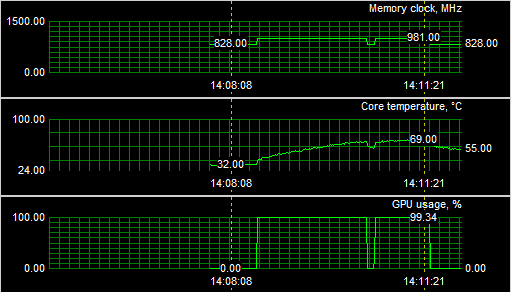Page 5 - Thermals, Wattage and noise levels
Power consumption
It's time to do some actual testing with these cards. We'll start off by showing you some tests we have done on overall power consumption of the PC. Power consumption is a big thing, and I'm thrilled to see what HIS has achieved here.
Looking at it from a performance versus wattage point of view, the power consumption is really good with the new 55nm products. Our test system is a Core 2 Duo X6800 Extreme Processor, the nForce 680i SLI mainboard, a passive water-cooling solution on the CPU, 2GB memory, DVD-ROM and WD Raptor drive. Have a look:
|
Videocard |
System Under load |
|
HD 2900 XT |
391 Watt |
| HIS HD 3850 ICEQ3 TurboX | 263 Watt |
Observe closely the difference between the 2900 and the 3850. Shocking as performance is nearly equal while wattage dropped well over a 100 Watts. A big thumbs up to AMD here, that's just brilliant as the performance is nearly the same.
In my view the Radeon HD 38xx series require you to have a 450 Watt power supply unit at minimum if you use it in a high-end system, and I think that's barely on the safe side. Also recommended is 28 AMP's on the 12 volts rails for stable power distribution (on a single card configuration)
Notice that the card uses one 6-pin power connector and not another one 8-pin connector.
If you have dough to spend and opt the guru path of righteousness by doubling up towards two/three/four cards in your system -> CrossfireX, then you should end up with a 800 Watt or better PSU with a 45 AMPs 12 Volts rail. Definitely check out this PSU review, please.
There are many good PSU's out there, please have a look at our many PSU reviews as we have loads of recommended PSU's for you to check out in there. What would happen if your PSU can't cope with the load?:
- bad 3D performance
- crashing games
- spontaneous reset or imminent shutdown of the PC
- freezes during gameplay
- PSU overload can cause it to break down
The HIS ICEQ3 thermal envelope
Let's have a look at the temperatures these cards produce. We measured at a room temperature of 21-22 Degrees C, look at idle temperature and then load the GPU 100% for a couple of minutes and measure the temperature once a second and follow the temperature delta.
|
|
||
 |
||
Above you can can observe the thermal envelope during a quick stress test. The idle temps are short from astonishing. Expect below 40 Degrees C idle temps. The the load temperature was high, and rose towards 69 Degrees C. Much better than the 90+ degrees C temps on the reference cooler though.
Noise Levels coming from the graphics card
When graphics cards produce a lot of heat, that heat usually needs to be transported away from the hot core as fast as possible. Often you'll see massive active fan solutions that can indeed get rid of the heat, yet all the fans these days make the PC a noisy son of a gun. I'm doing a little try-out today with noise monitoring, so basically the test we do is extremely subjective. We bought a certified dBA meter and will start measuring how many dBA originate from the PC. Why is this subjective, you ask? Well, there is always noise in the background, from the streets, from the HD, PSU fan etc etc, so this is by a mile or two not a precise measurement. You could only achieve objective measurement in a sound test chamber.
The human hearing system has different sensitivities at different frequencies. This means that the perception of noise is not at all equal at every frequency. Noise with significant measured levels (in dB) at high or low frequencies will not be as annoying as it would be when its energy is concentrated in the middle frequencies. In other words, the measured noise levels in dB will not reflect the actual human perception of the loudness of the noise. That's why we measure the dBa level. A specific circuit is added to the sound level meter to correct its reading in regard to this concept. This reading is the noise level in dBA. The letter A is added to indicate the correction that was made in the measurement. Frequencies below 1kHz and above 6kHz are attenuated, where as frequencies between 1kHz and 6kHz are amplified by the A weighting.
| TYPICAL SOUND LEVELS | ||
| Jet takeoff (200 feet) | 120 dBA | |
| Construction Site | 110 dBA | Intolerable |
| Shout (5 feet) | 100 dBA | |
| Heavy truck (50 feet) | 90 dBA | Very noisy |
| Urban street | 80 dBA | |
| Automobile interior | 70 dBA | Noisy |
| Normal conversation (3 feet) | 60 dBA | |
| Office, classroom | 50 dBA | Moderate |
| Living room | 40 dBA | |
| Bedroom at night | 30 dBA | Quiet |
| Broadcast studio | 20 dBA | |
| Rustling leaves | 10 dBA | Barely audible |
We start up a benchmark and leave it running for a while. The fan rotational speed remains constant. We take the dBA meter, move away 75 CM and then aim the device at the active fan on the graphics card.
Obviously the card does not make a lot of noise at all, you have to close in on the system to be able to hear it. We measured the PC at 39-40 DBa which is really good.
